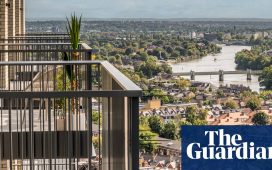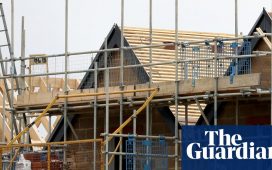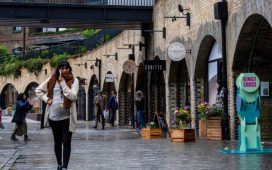When I was a child, my parents, who worked in theatre, couldn’t make up their minds whether to relocate from Canada to London, New York or LA. Even though the top rate of UK income tax was then 83 per cent, they eventually opted for London because of the availability of places in “good” schools and choice of houses as attractive as the one they already owned.
As we approach the October Budget, similar considerations are under discussion at the dinner tables of the “non-doms”. The government’s proposed legislation on non-doms is intended to remove the 225-year-old concession that allowed those living in the UK but “domiciled” elsewhere an exemption on income and capital gains earned abroad for up to 15 years. For a select few, it will make Britain a significantly less welcoming place to live, work and send children to school. Many are now seriously considering their alternatives. Of course there are tax considerations, but lifestyle ones are also paramount and the property landscape of the most fiscally attractive cities is playing a significant part in decision-making.
One Must-Read
This article was featured in the One Must-Read newsletter, where we recommend one remarkable story each weekday. Sign up for the newsletter here
“Everyone is in deep huddles with their tax advisers trying to discover what the legislation might mean for them,” says Roarie Scarisbrick, London partner of international property search company Property Vision. “They’re bouncing around Lisbon, Athens, Tuscany — discussing how they can change their lives to lessen the hit. But every destination has its complications, none is a slam dunk.”
Locations long favoured by the wealthy, such as Switzerland, continue to exert their charm. Its low income and wealth taxes sit persuasively alongside its other sterling virtues: security, confidentiality and consistency. The lakes and mountains are also highly seductive for both adrenaline-seeking hiking, sailing and skiing types, and the C-suite for whom escape into nature’s breathtaking vistas is a way to switch off. The plethora of both traditional and cutting-edge wellbeing retreats is also a draw.

“We’ve already had quite a few inquiries from those who want to leave the UK,” says Maxime Dubus, managing director of SPG One in Geneva, specialists in luxury real estate. “Our tax is attractive, and we have a strong banking system and education, but it’s our stability that really stands out.”
Émigrés investigating Switzerland are looking primarily in Geneva, Zurich and five-star ski resorts, but those without an EU passport or longtime residency will quickly discover that the Swiss have a complex raft of purchasing legislation encapsulated in the Lex Koller, which is intended to invigilate who buys what where — in effect restricting foreign buyers.
But in some cantons, holiday homes are exempt from the authorisation required, meaning international buyers often favour chalet living in mountain resorts such as Verbier, which offers the dual attractions of excellent skiing and an International Baccalaureate school.
Monaco, another historic favourite with the private jet set, would appear to have it all — no tax on income, capital gains or property, unparalleled security, a bull’s-eye location in Europe and lashings of Riviera chic. Here, a mix of old-school international glamour and new money come together in sceney restaurants, high-luxe shops, yachting hubs — and for the Formula One Grand Prix. However, where to live remains an issue.
Not only is property per square foot the most expensive in the world but the fact that Monaco is unusually petite — smaller than Central Park — means neighbours are inevitably cosily near and there is limited scope for further development. This year and next, it’s true, will see some exceptional arrivals. Most notable is the Le Renzo, the 110 apartments and 10 villas designed by Renzo Piano on Mareterra, the principality’s $2.4bn six-hectare land extension, which will contribute 3 per cent to the landmass.

According to Irene Luke, co-head of Savills Monaco, the development sold out off the plan, and is now seeing resale units valued at €100,000 per sq m. On existing territory, house-hunters can still find space in the 56 apartments and five villas at Bay House in Larvotto, which will house the International School of Monaco. However, for those accustomed to the abundant haute living in London and New York, what’s on offer elsewhere can often seem disappointingly lacklustre.
“The developments at Mareterra and at Bay House are very exciting, but they won’t add significantly to the supply,” says Luke. “Renovation is happening much more regularly, but there’s still quite a few buildings constructed in the 1970s that look a bit tired.”
Monaco is, of course, only a short drive from Italy, and a palace in the old-world glitzy splendour of Lake Como has long been a staple of a top-tier property portfolio — but Italy as a whole has only recently become a serious contender as a European wealth hub. The country’s 2017 tax initiative — which came to be known as svuota Londra (empty London) — enticed both new residents and Italian nationals who had lived outside the country for at least nine years with a flat tax of €100,000 a year on foreign income and assets (as well as a 15-year exemption from inheritance tax on foreign assets). The scheme has now survived five governments, but last month the Meloni government approved a rise in the annual levy to €200,000. Not enough to deter all, but potentially a sign the scheme might not stay so attractive.
And that’s not the only snag.
“Italy’s flat tax has been successful in repatriating Italians living abroad as well as attracting foreigners who want to establish primary residency,” says Massimiliano Bulzoni, managing director of Exclusive RE/Christie’s International Real Estate in Rome, Milan and Naples. “The difficulty is they generally want to live in the centre of Rome or the centre of Milan and, unfortunately, there’s just not enough of the right type of property.”
Nearly all of Milan’s residential inventory consists of apartments in historic buildings, and though a newer crop of luxury high rises — including Isola’s Bosco Verticale, the Torre Aria in Porta Nuova, and the Arquitectonica-designed Torre Solaria in Porta Garibaldi — has improved the stock of state-of-the art penthouses, the supply remains miserly.

Some are resolving the scarcity by purchasing palazzo perfection nearby, and Lake Como, just an hour away and blessed with magnificent lakeside villas, a multitude of Michelin-starred restaurants and an international school, has been a beneficiary, seeing prime prices, according to Knight Frank, rise by 4 per cent in 2023. Unfortunately, businesses and banks don’t have the same option. For the time being, Milan is likely to remain a city more celebrated for its furniture and fashion than its financial services.
The same cannot be said of Miami, another beneficiary of charismatic fiscal arrangements. Florida’s tax appeal — with no personal income, inheritance or capital gains at state or local level — is self-evident, but its corporation tax is also seductive, encouraging big names in tech, finance and legal firms (such as Microsoft, Blackstone and Goldman Sachs) to set up shop. Long seen as “the capital of Latin America”, Miami, with its Art Deco architectural history, shiny new-builds and alchemy of beach chic and art-and-design buzz, is also attracting multi-millionaire migrants from the US and elsewhere. Last year, for instance, Amazon founder Jeff Bezos announced his decision to relocate from Seattle, purchasing three properties (for a reported total of $237mn) on 300-acre Indian Creek Island, popularly known as billionaire’s bunker.
Prices in prime locations, such as Palm Beach, have more than doubled in the past four years, and significant investment in offices, restaurants and culture — such as Art Basel, Miami Beach — are also helping augment the city’s reputation as a tastemaking global hub. Demand is not confined to Palm Beach, and Knight Frank sees exciting potential in West Palm Beach, which is reinventing itself as a redevelopment hotspot, with projects such as Olara Residences, Alba and Mr C, and South Beach — “SoBe” — where Five Park is set to become the tallest luxury building on Miami Beach when it is completed later this year.

Here, however, rapid growth has put a strain on what many consider essential resources.
“Some people hesitate to transition here because we simply can’t match the level of education on offer in New York,” says Bill Hernandez of Douglas Elliman estate agents. “When they do make the move, there’s a big competitive market to get their kids into the handful of private schools we have.” Indeed, private school acceptance is often now a condition of home purchase.
Dubai is also relative newbie in global wealth circles. Its zero income tax and 10-year automatically renewable Golden Visa programme (whose benefits include long-term residency and the ability to own property) attracts a steady flow of multimillionaires from India, Russia, Africa and Europe. Life is sunshine-soaked razzle dazzle, where high-priority pleasures include myriad air-conditioned shopping malls. And there is an embarrassment of riches when it comes to super-prime accommodation — an extensive array of indulgent accommodation with seafront views of the Gulf.
Such is demand that the top 5 per cent of the market, in locations such as Emirates Hills, Jumeirah Islands and the Palm Jumeirah (where Knight Frank is selling an eight-bedroom villa for £33.147mn), has seen an 85 per cent price rise in the five years to June 24, and the leap has helped make Dubai this year’s top trump in terms of property valued at $10mn or more (double the number of its closest competitors, New York and Palm Beach). Everything here, however, is not quite as gold-tinted as it might at first appear.

“Dubai’s total of super-prime sales is very strong compared to other cities,” says Liam Bailey, partner and global head of research at international estate agent Knight Frank, “but the recent data marked the first quarterly decline since we started our survey in 2019. The crazy price rises of recent years mean Dubai has now become expensive compared to other global cities, with hot competition for services and accommodation. It needs to grow quickly.”
Dubai’s pivotal location between east and west is one of its many assets, and it’s likely to benefit further from Asia’s increasingly wealthy population, set to grow faster than any other region in the coming years, according to Knight Frank’s 2024 Wealth Report. But competition to host newly minted migrants is intense and, nearer to home, Singapore and Hong Kong have been battling it out for the privilege. The report finds that Hong Kong is likely to remain the “dominant” choice for billionaires from the Chinese mainland but that wealth from elsewhere is now looking towards Singapore, an increasingly attractive destination for ultra-high net worth individuals from Indonesia, Thailand, Malaysia and Vietnam as well as North America and Europe.
House & Home Unlocked

Don’t miss our weekly newsletter, an inspiring, informative edit of the news and trends in global property, interiors, architecture and gardens. Sign up here.
With high standards of education, health and security, and a reputation for openness and integrity, the city-state has further strengthened its appeal by introducing a number of tax incentives and a business-friendly regulatory regime to entice family offices to relocate. What it isn’t doing, however, is encouraging foreign nationals to buy a home. Responding to fears that locals were being driven out of the housing market, last year it introduced a 60 per property cent purchase tax for foreigners, almost doubling the 2022 rate and, according to Savills, making Singapore the world’s most expensive major city in which to buy a home.
The influence wealthy homeowners have on property prices has tended, sooner or later, to have vote-impacting consequences. In 2023, for example, Portugal abruptly announced the termination of its 15-year-old “non-habitual residents” regime (which allowed high net worth individuals to enjoy reduced tax on Portuguese income and exemption on most foreign income for 10 years), with future arrivals not able to access its preferential terms “because it was no longer beneficial”. Canada, too, responded to a perceived excess of top-end overseas purchasers by introducing foreign-buyer levies of 20 per cent in Vancouver.
Might the right solution for the UK’s non-doms be: just stay put? “Ultimately, London will always remain an attractive place for wealthy international buyers, either as an investment or personal use,” says Shaun Drummond, residential sales director of Harrods Estates. “World-class schools and universities, culture, relative political stability, and its timezone between Europe and the US, ensure it remains high on the list of desirable global cities.”
Find out about our latest stories first — follow @FTProperty on X or @ft_houseandhome on Instagram








